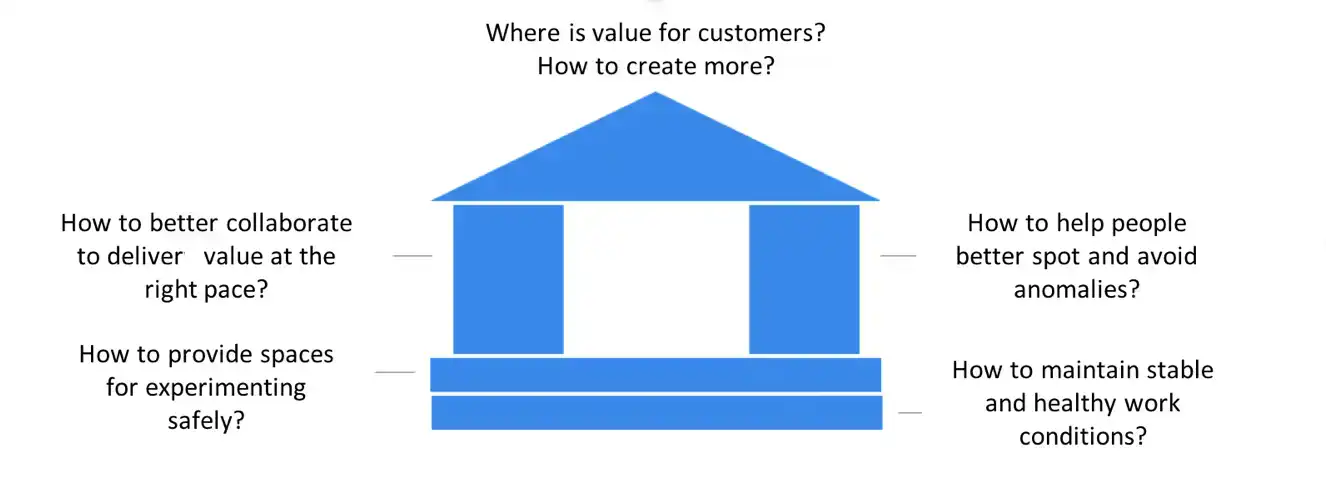Now is the time for resilience and adaptability!
Drawing from TPS - the Thinking People System - enables resilience. But leaders need to put in the required energy.

In these last few months of having to operate at reduced capacity, while learning to apply new safety rules, our ability to adapt swiftly has been put to the test. While some organizations have met this initial test, proving their resilience, others are still struggling. Beyond confronting sector-specific issues, the biggest challenge for all is in the relationship they have towards change. Are people and companies anticipating and embracing change? How quickly are they able, and willing, to react to unexpected situations?
This spirit of “pick ourselves up and let’s keep going no matter what” is the true spirit of lean. We know that the next storm is around the corner, so we’d better be prepared.
This is particularly visible in the digital world where one might assume that everyone is prepared to work remotely. And yet some companies struggle with coordinating activities, or they see their customers slipping away. Others are navigating the COVID crisis. Consider the work of the Urban Institute: this DC-based think tank, which carries out economic and social policy research, got their 500 employees working remotely within a week. Khuloud, the VP of tech and data, attributes their swift and seamless transition to the fact that she and her teams have been practicing lean for five years. They were able to quickly identify new problems and together build innovative solutions. Another example is Proditec, a leading French manufacturer in the pharma industry, whose CEO says that adopting a lean strategy has helped him and his staff through this crisis and past ones.
In the digital world, there are several stories of cooperation and adaptability in response to the crisis, such as this one: lean tech service companies BAM, Sipios, and Padok joined forces to build the platform for French businesses to apply for government loans during lockdown. Their teams did it in just five days while working from home.
A company is only as resilient and adaptive as its people. TPS, the “Thinking People System,” lies at the heart of this principle. TPS gives us a framework, with its tools and principles, to develop resilient and adaptive people, and thus companies:

Creating value for customers
The first condition for building resilience is to keep customers fully satisfied and loyal. Assuming that customers’ desires don’t change in “normal” conditions is foolish. Yet, this is what I see happening frequently, even now that needs and wants have obviously changed overnight. In normal AND extreme situations, we must continuously ask ourselves if we are creating real value for customers: do we know what they are going through at the moment? Do we know how we can help them resolve their new problems? What must we learn to do better to keep them interested and support them? This was the case of AramisAuto.com, a leading online car-selling firm, that figured out safe delivery solutions for customers who needed a car in the current crisis. The alternative was shutting down.
Delivering value at the right pace
One big problem the COVID crisis is causing is a rupture in supply chains, which is creating shortages everywhere in turn, from medical equipment to groceries. The reason given by the media is that we haven’t built enough stocks to prepare for a possible crisis. But can we really predict this, years ahead of time? How much stock would be enough to ensure we don’t run out at some point? How long would we be able to keep the stock before it becomes obsolete? The true reason behind the supply chain problems is that we have been unable to keep up with the sudden increase in demand, just like with masks and hand gel. Delivering value at the right pace means that we are able to produce only what the client needs at the time they need it, and we are able to adjust our means of production and delivery when the demand increases or decreases. Delivering what the client needs when they need it is a matter of flexibility, not foresight.
Helping people spot and resolve anomalies
Delivering value at the right pace entails reliability, i.e. reducing the number of uncertainties and reworking early in the value chain. This can only be done if people are able to: 1) recognize anomalies as they work, 2) know how to fix them alone in most cases, and 3) get immediate help when they run into issues. However, these three conditions are rarely met at the same time. Knowing how to spot and resolve a defect or something that will create a defect down the line requires expertise and good judgment. Both are developed with continuous training and work standards. But getting help when we are stuck, have a doubt or lag behind requires having in place a structured managerial “chain of help”. In the office, one can easily turn around and ask for help, but multiple interruptions generate other types of problems (“stop and go”, not getting enough done). At home, alone in front of our computer, we are quickly stuck when colleagues don’t answer right away. In both environments, the chain of help must be better defined and maintained. Apricity, a leading UK virtual fertility specialist, started setting up Kanban and Andon systems to encourage collaboration and problem-solving. This proved quite useful during lockdown.
Providing safe spaces to experiment
Adaptability comes from continuous experimentation. As conditions continue to change around us, our ability to learn fast allows us to stay ahead of the curve. In a lean organization, every person is constantly experimenting with their own work, so they are unafraid of change. Managers encourage them to run experiments without the fear of failure or reprimand. Elsewhere, many managers continue to put pressure on people to deliver and not to question the way things are done. During challenging times, command-and-control management usually has the upper hand. On the contrary, it is better to provide safe spaces (both physical and temporal) in which people can take a step back from daily work and try new ideas. When push comes to shove, they will be ready to react quickly, decisively and creatively, and this ability is what will overcome inertia. At UK-based online temp car insurance Veygo, the team took it upon themselves to propose a 75% discount to NHS workers so “they could go to work as safely and cheaply as possible.” JB, the head of Veygo, congratulated and supported them for their initiative.
Maintaining stable and secure work conditions
All of the above is only possible if people work in secure and stable conditions. How can we ask anyone to signal anomalies or to experiment if their managers are not taking their daily problems seriously? The stability layer of the TPS framework is at the foundation of the model because it is built on the notions of respect for people and trust. Managers’ one and only obligation is to facilitate the success of their team by giving them all the resources they need, helping with resolving difficult problems and letting people modify their own work environment as they see fit. In the current context, it’s even more important as everyone has lost their bearings, and finds themselves juggling family life and work. For instance, Khuloud provided each employee a nifty budget so they could purchase any equipment they needed to work comfortably and safely in their home (computers, chairs, noise-reducing headphones, etc).
The “Thinking People System”, as its name suggests, is a system for making people think: think about their own work and how to deliver more value for customers. This is how organizations can create the conditions for building their own resilience. But for this to work, leaders still need to put in the necessary energy: the will to examine the facts as they are and to give their teams the space for experimenting and making their contributions.
This story was originally published by Sandrine on lean.org.